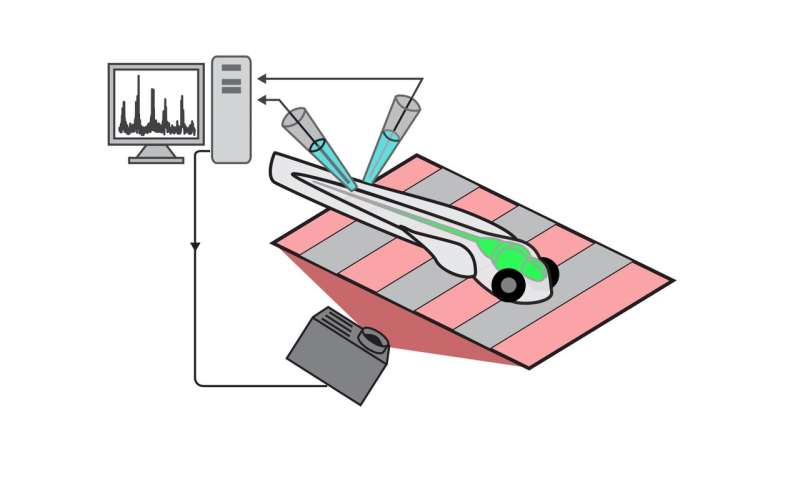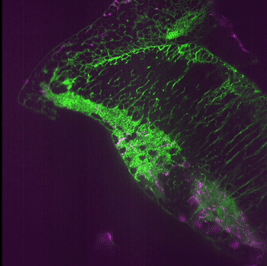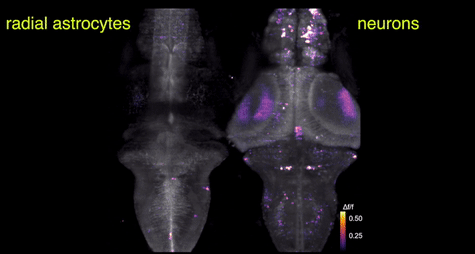Frustrated fish give up thanks to glia, not just neurons

Secured in place in a virtual-reality-equipped chamber, frustrated zebrafish just didn't want to swim anymore.
They had been "swimming" along fine, until the virtual reality system removed visual feedback associated with movement. To the fish, it appeared as if they were drifting backward, regardless of how hard they stroked.
First, the fish thrashed harder. Then, they simply gave up, says neuroscientist Misha Ahrens, a group leader at the Howard Hughes Medical Institute's Janelia Research Campus. "Giving up is a very important thing for animals to be able to do," he says. Without the ability to stop a behavior that's not working, animals would needlessly deplete their energy.
Ahrens and his team at Janelia wanted to identify the neurons responsible for the decision to quit. The researchers watched the zebrafish's brain activity patterns as they struggled. But the clearest signal wasn't coming from neurons. The cells that sprang into action just before the zebrafish called it quits were actually glia, long thought to play a supporting role in the brain.
The find, reported June 20, 2019, in the journal Cell, is clear evidence that cells other than neurons can perform computations that influence behavior—a discovery so surprising that the team took pains to verify their work, Ahrens says.
"We were excited and also very skeptical," he says. "We challenged ourselves to try and disprove it."

More than glue
Until about two decades ago, scientists thought glia (from the Greek for "glue") just provided support and insulation for neurons. But recent research has begun to uncover new roles for glia in processing. Now, Ahrens, Janelia Research Scientist Yu Mu, and their colleagues—Davis Bennett, Mikail Rubinov and others—have shown that, in zebrafish, one type of glial cell can calculate when an effort is futile.
"The original hope was that we would find the neurons that drive this 'giving-up' behavior," Ahrens says.
A whole-brain imaging technique previously developed at Janelia let the researchers look at all of a fish's brain cells, both neurons and glia, while it tried to swim. Then, the team compared the different cells' impact on behavior.
But surprisingly, the team had trouble identifying specific neurons that clearly impacted swimming behavior. Glia were a different story, Mu says. Certain glia, called radial astrocytes, amped up their activity in one part of the brain when the animals stopped trying to swim.
Neurons weren't completely out of the loop: each time a movement attempt failed, certain neurons revved the astrocytes up, until at last they crossed a threshold and sent the quit command. That command went out to a different set of neurons, which then suppressed swimming.

"You could think of the astrocytes as a counter for how many swim bouts have failed," says Mu. It's not a simple job: To tell the fish when to give up, the glia must monitor movement attempts, note repeated failures, and then send the "quit" message to the body.
Control astrocytes, change behavior
To verify the astrocytes' role, the researchers first used a laser to kill only the ones that consistently turned on when the fish gave up. In fact, the team found, fish who lacked those cells continued struggling to swim much longer than the fish whose astrocytes remained.
Next, the team created fish with astrocytes the team could control. Switch on the astrocytes, and the fish stop swimming, the team found, even when the visual environment wasn't messing with them. While normal fish rarely pause, fish with overactive astrocytes spent over half their time languishing in defeat. Taken together, these experiments confirmed that radial astrocytes indeed control the decision to stop swimming, Ahrens says.
One next step for the group will be studying exactly how the astrocytes communicate with neurons. Astrocytes can, for example, release chemical messengers that affect neuron behavior, Mu says. "Astrocytes are like a swiss army knife." Mu wants to identify which of their many tools they deploy to halt unproductive struggle.
More information: Yu Mu, Davis V. Bennett, Mikail Rubinov, Sujatha Narayan, Chao-Tsung Yang, Masashi Tanimoto, Brett D. Mensh, Loren L. Looger, and Misha B. Ahrens. "Radial astrocytes encode and suppress futile actions." Cell. Published online June 20, 2019. DOI: 10.1016/j.cell.2019.05.050
Journal information: Cell
Provided by Howard Hughes Medical Institute



















